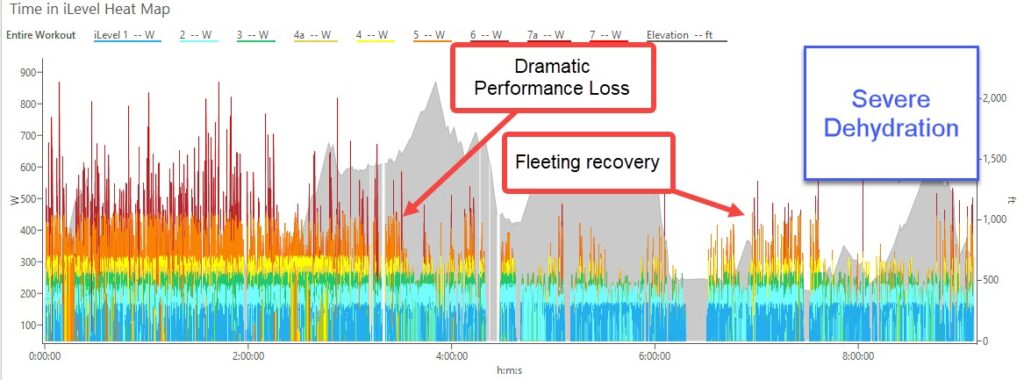Dehydration Drives DNFs at Gravel Races
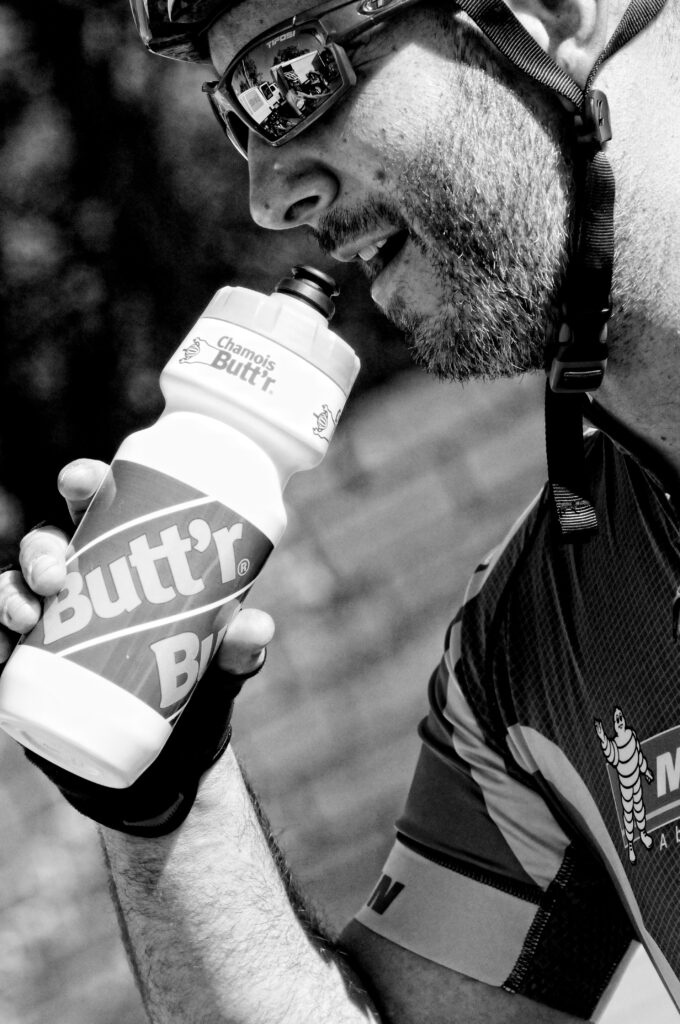
Hot Sweaty Summer
Something interesting, but not surprising, happened this summer. It began as random occurrences but as the summer progressed a pattern had developed. The primary reason that athletes did not finish (DNF) gravel races (ultra-endurance events) was due to dehydration and complications that arise from it. That's right, it's that simple, dehydration drives DNFs at gravel races.
Knowing that the summer of 2023 was the hottest on record meant that many competitors in gravel races needed to adapt their existing strategies or wilt under the unrelenting pressure of the summer heat. Many made the changes but many did not and those athletes suffered DNFs at record rates.
What we Know About Hydration and Performance Loss
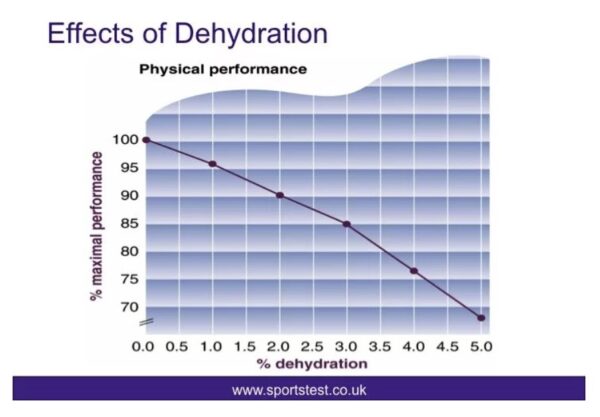 We may not know a lot about why, at the subcellular level, performance loss happens with dehydration but we know a lot about the end product. Your performance drops dramatically as you dehydrate and the decline accelerates as you become gradually more dehydrated. 2% loss of body mass to dehydration results in 5% loss of performance. A 5% loss of body mass to dehydration can lead to a 30% performance drop. 7% loss will almost always result in heat illness, DNF and a high likelihood of a trip to the hospital. In fact, in one study 87% of the participants quit or were removed for safety reasons when they were dehydrated to 7% of their body mass which makes it more believable when we conjecture that dehydration drives DNFs at gravel races
We may not know a lot about why, at the subcellular level, performance loss happens with dehydration but we know a lot about the end product. Your performance drops dramatically as you dehydrate and the decline accelerates as you become gradually more dehydrated. 2% loss of body mass to dehydration results in 5% loss of performance. A 5% loss of body mass to dehydration can lead to a 30% performance drop. 7% loss will almost always result in heat illness, DNF and a high likelihood of a trip to the hospital. In fact, in one study 87% of the participants quit or were removed for safety reasons when they were dehydrated to 7% of their body mass which makes it more believable when we conjecture that dehydration drives DNFs at gravel races
As a coach, I can tell you that event outcomes due to a 3% difference in performance can be enormous. 3% more ability during a defining moment of a race could put you in a group that rides at 8-10% faster speeds for the remainder of the day, a difference of up to an hour in a gravel race finishing time. In a marathon, a 3% difference in running economy would mean that one athlete could run the race 20 minutes faster than the other.
Common signs and symptoms of dehydration
This is a list of common things that happen when an athlete becomes dehydrated and possibly DNF of your gravel race. Remember that these are not “on/off” but will have a gradual onset. What starts as a feeling of “I’ve surged enough for right now,” could develop into a state of being “completely cracked” with another hour of progressive dehydration. Without intervention any of these can be catastrophic. However, you will never experience just one symptom but many simultaneously.
-
- Thirst- humans have a poor thirst reflex so by the time this happens you’re already dehydrated
- Dry mouth and lips
- Decreased urination- not going for hours is not a good thing
- Dark-colored urine- if it looks like you “ate a highlighter” then you’re probably in trouble
- Fatigue- when riders who were all-in on riding hard are now missing turns and seem apathetic
- Thirst- humans have a poor thirst reflex so by the time this happens you’re already dehydrated
- Dizziness or lightheadedness
- Headache- very common when athletes are dehydrated
- Confusion- Usually presents as being unaware of a big climb or the location of the next aid station. Generally, missing basic technical things. “What is that person doing?!”
- Muscle cramps- I could do an entire webinar about the current knowledge of cramping but dehydration is an influencer
- Cardiac drift- very easy to see in a workout file
- Nausea from low blood pressure- If you’re sitting at an aid station and you get up and get woozy.
- Upset stomach or gut rot- It’s probably not from drinking too much. If you’re not matching your sweat rate and you’re not drinking anything “new.”
The hotter and more muggy, the more athletes will feel multiple symptoms at once are primed to succumb to dehydration driving DNFs.
Seeing Dehydration Performance Loss in Your Workout File
In order to look at a file and see severe dehydration we must first qualify the athlete and their training, then ask some questions about the day’s performance to rule out other causes like under-eating, poor pacing or simply not being fit. Next, we need to do a deep dive of the workout file to account for over-racing/ over-pacing. Finally, we need to know that the athlete is well trained for an event of this length or workload (kJ). If all those qualifiers are met we'll get an example like this:
The file above looks spot on for dehydration especially when you compare it to this one just a few weeks later, and after refining the hydration strategy:
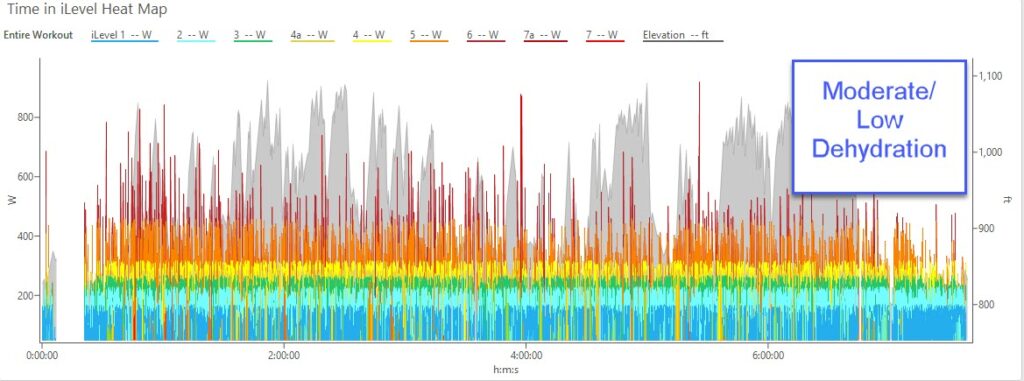
Upon further investigation we discovered a few things from the first file:
- The athlete had executed a hydration strategy of 1.5 L/ hr of fluids.
- The athlete recovered late in the day but the hydration was fleeting as there was another collapse later.
- After we did an approximation of this athlete’s sweat rate we discovered that there was a need to drink 2-2.5 L/hr of fluids to maintain hydration. This strategy was executed in the second file seen above.
Preventing the Dehydration Performance Collapse
To prevent this apparent epidemic where dehydration drives DNFs at gravel races, we first need to find your sweat rate:
This simple survey isn’t hard to do but it’s always surprising how many athletes simply don’t have the answer to the simple question, “how much do you sweat per hour?” Obviously you’ll sweat more during a tough ride than a recovery day so pick a medium day and a hard day to do the test. It’s best to do the test 3-5 times so you have a good baseline of data.
Sweat Test
Please understand that this is only an approximation. The idea is to get a general idea of your sweat rate.
- Weigh yourself, nude, just before you ride.
- Record how much you urinate during the ride. Best guess.
- Record how much you drink during the ride. You should know how many ounces of fluid your bottles hold. If not, figure that out.
- Weigh yourself, nude, at the end of the ride.
- Math: Pre-ride weight + fluids consumed- fluid urinated- post ride weight.
- Gives you total weight difference.
- Divide that weight difference by ride time.
- Minimum stoppage time on these rides.
- Now you have fluid lost per hour!
This is the amount you’ll have to drink to maintain your beginning level of hydration.
How Dehydrated Can I Go Before Suffering Huge Performance Loss?
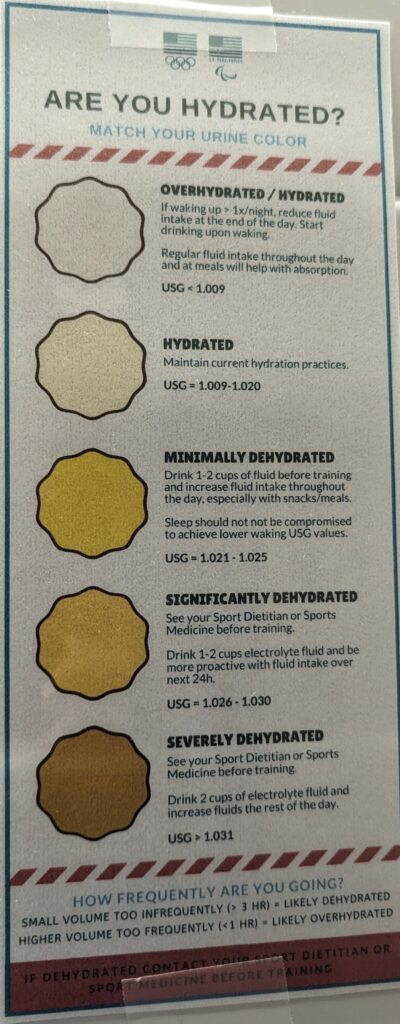 As we discussed before, a 2% loss of body weight to dehydration will result in ~5% loss in performance while a 5% loss of weight will yield a 30% drop in performance. Let’s assume 3% is your acceptable limit. You can do that math at home but it’s probably less than 6 lbs of water weight which is around ¾ gallon. Seems like a lot but this number becomes important for planning and executing your pacing and aid station strategy.
As we discussed before, a 2% loss of body weight to dehydration will result in ~5% loss in performance while a 5% loss of weight will yield a 30% drop in performance. Let’s assume 3% is your acceptable limit. You can do that math at home but it’s probably less than 6 lbs of water weight which is around ¾ gallon. Seems like a lot but this number becomes important for planning and executing your pacing and aid station strategy.
Take Home Message
The important message from this article is that you, the athlete, understand how much you’re sweating and the performance implications for that sweat rate. We science types usually discuss it in metric terms so something like 32-64 oz per hour is a normal sweat rate. A general rule I convey to clients is to never skip an aid station and that oftentimes the fastest way to the finish line requires stopping to fill your bottles at each opportunity. Of course optimizing your hydration strategy can help even more.
Thanks for reading and good luck!
About the Author:
Adam Mills has raced at the elite level since 2002 and graduated with a Masters Degree in Exercise Physiology from the University of Kansas in 2005. His true talent comes with his ability to combine his vast experience with his knowledge of sport. He is indeed a student of science, sport, athletic performance, strategy, and tactics. He continuously educates himself by keeping up to date with current research trends and methods in sport and his clients have reaped the benefits from this work with over 25 national championships in 11 disciplines on two continents. Adam is able to incorporate these attributes on a daily basis to help his clients reach and exceed their goals whether they are a beginner or a seasoned professional. Learn more about Adam and Source Endurance here.

